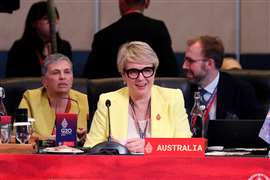Australian government approves world’s ‘largest solar precinct’
21 August 2024
Australia said it had given the go-ahead for an AUD$20 billion (US$13.5 billion) solar project that plans to ship energy from a giant solar farm in the country’s north to Singapore through a 4,300 km (2,672 miles) undersea cable, says news agency Reuters.
 Australian Environment Minister Tanya Plibersek attends the G20 Environment and Climate Ministers’ Meeting in Nusa Dua, Bali, Indonesia (Photo: Made Nagi/Pool via REUTERS/ File Photo)
Australian Environment Minister Tanya Plibersek attends the G20 Environment and Climate Ministers’ Meeting in Nusa Dua, Bali, Indonesia (Photo: Made Nagi/Pool via REUTERS/ File Photo)
Environment Minister Tanya Plibersek said SunCable’s flagship Australia-Asia power link project would help meet growing demand for renewable energy at home and abroad.
A final investment decision is expected in 2027 with electricity supply to begin in the early 2030s, according to SunCable.
The approval comes with strict conditions to protect nature and the project must avoid the habitat of greater bilby, which are small rabbit-like marsupials with long floppy ears, Plibersek said.
Over two stages of development, the project aims to deliver up to 6 gigawatts of green electricity to large-scale industrial customers in Darwin, the capital city of Australia’s Northern Territory, and in Singapore.
The approval comes as the centre-left government ramps up renewable energy projects even as the opposition coalition proposes building nuclear plants to replace coal-fired power by 2050, in a country where nuclear power is currently banned.
SunCable, owned by billionaire Mike Cannon-Brookes, said the approval was “a vote of confidence” in the project.
Cannon-Brookes, the co-founder of tech firm Atlassian turned environmental activist, last year said the project was viable and that outside investors would be drawn to the project.
“SunCable will now focus its efforts on the next stage of planning to advance the project towards a final investment decision targeted by 2027,” Cameron Garnsworthy, managing director at SunCable Australia, said in a statement, which did not provide details of its financing plans.
SunCable said it was in talks with Singapore’s energy regulator on the conditional approval for the project’s cable inter-connector component and with the Indonesian government on building the cable in its waters.
The project received clearance from the Northern Territory government and the territory’s environment watchdog last month.
CONNECT WITH THE TEAM





